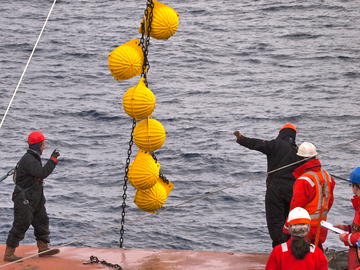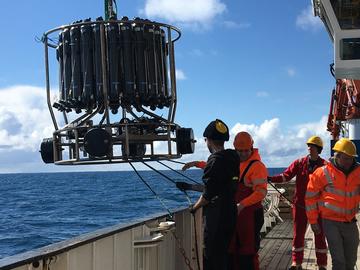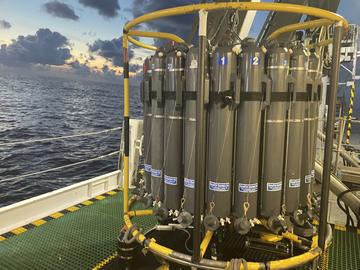Long-term ocean data challenge assumptions about regional differences in the ocean’s natural carbon sequestration potential

Ocean scientists in the field (Photo credit: Heather A. Bouman)
A new publication by researchers from Oxford Earth Sciences shows that the relationship between water temperature and the main biological mechanism by which the ocean captures atmospheric CO2 is far more complicated than previously thought. Drawing on long-term time-series data from oceanographic stations across the globe, the research highlights how the quality of currently available data limits our understanding of this critical mechanism in the carbon cycle.
The biological carbon pump (BCP) is a critical part of Earth’s carbon cycle, removing CO2 – the main greenhouse gas responsible for global warming – from the atmosphere and locking it away in the deep ocean. This occurs when microscopic organisms called phytoplankton take in CO2 during photosynthesis or by creating calcium carbonate shells, then die and sink through the water column, carrying the CO2 with them.
Known as “marine snow”, this shower of biogenic particulate material transfers an estimated 10 billion tonnes of carbon every year into the ocean's interior, roughly the same amount as that emitted annually by fossil fuel burning. As a result, it plays an important role in regulating the amount of CO2 in the atmosphere and hence Earth’s climate.
How efficiently the ocean’s BCP transfers carbon-rich marine snow to the deep ocean – known as transfer efficiency – is a fundamental research question which scientists have grappled with for decades, and which has acquired new urgency due to climate change.
“The BCP provides an essential ecosystem service, naturally removing excess CO2 from the atmosphere and regulating the temperature of our planet. In a world where CO2 removal techniques are becoming increasingly important, understanding this fundamental ocean process is vital for recognising its potential contributions in the coming decades.”
- Professor Heather Bouman, study co-author
Researchers are still unsure how global warming will impact this essential process, which relies on a delicate balance of factors, including temperature and nutrient availability. Ocean scientists have long thought that temperature is the main driver of the BCP’s transfer efficiency, and therefore that it would be expected to vary geographically with latitude.
However, when lead researcher Dr Anna Rufas was developing a computer model of marine snow for the global ocean as part of her doctoral thesis, she encountered an unexpected result: her model did not show the anticipated relationship. This finding prompted Dr Rufas, her supervisor Professor Samar Khatiwala, and collaborator Professor Heather Bouman, to dive deeper into the data she had assembled to build and validate her model.
“I re-analysed available information about the BCP from six locations across the globe with long records and good quality data, each representing a different environment. Additionally, I included data from a range of national and international research projects, using a variety of methods including sediment traps, radiometric techniques and underwater cameras. By combining these methods, I was able to capture a more comprehensive picture of the complexities involved in measuring the transfer efficiency of the BCP across different ocean sites around the globe.”
- Dr Anna Rufas, lead author

Ocean scientists in the field (Photo credit: Heather A. Bouman)
Using this data, the research team were unable to definitively conclude that variations in the transfer efficiency of the BCP over the global ocean are driven by temperature. This is largely because variations in the data – stemming from differences in experimental methods or natural fluctuations (just as the atmosphere, the ocean also has “weather”) – masked any potential trends, raising the question of whether such trends exist at all.
Professor Samar Khatiwala, study co-author added: “Many in the oceanographic community will find our conclusion surprising, perhaps even hard to swallow. Previous work using some of the same data has argued for a strong relationship between transfer efficiency and temperature, although different researchers have reached contradictory results! But anyone who has been on a ship knows that the ocean is a pretty “noisy” place. That makes identifying patterns incredibly challenging, even more so for complex processes such as the biological carbon pump, where the data is spotty at best and often collected using very different measurement techniques. A relationship may well exist in nature but Anna’s careful analysis taking these factors into account makes us question some long-held assumptions.”

Scientific equipment on an ocean vessel (Photo credit: Heather A. Boumann)
Dr Rufas believes that the differences between methods across research projects can explain the absence of any clear patterns, principally because there are no standard method protocols and therefore large differences between the approaches of research groups studying this problem.
She said: “At the largest international ocean science conference, the AGU’s Ocean Sciences Meeting, held last February 2024 in New Orleans, USA, I gathered with a group of ocean biogeochemists to discuss the issue of lack of protocol standardisation in the collection of marine particle data. We also highlighted the need to improve the collection of data in traditionally under sampled areas, such as polar regions in the winter, which are crucial for ocean carbon sequestration. The outcome of this discussion will soon be published as a collaborative report. Stay tuned for the highlights, which we hope will serve as a strong call to action for ocean scientists to harmonise data collection and processing protocols in the study of the BCP.”
The study ‘Can We Constrain Geographical Variability in the Biological Carbon Pump's Transfer Efficiency From Observations?’ is available to read in Geophysical Research Letters at https://doi.org/10.1029/2024GL111203.




